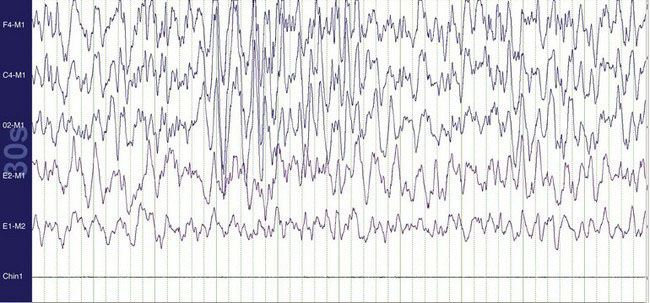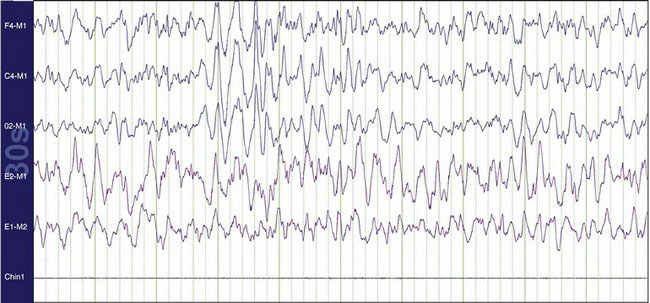Section 8 Parasomnias
8.1 Non–Rapid Eye Movement Parasomnias
Get Clinical Tree app for offline access

A 7-year-old boy has had episodes at night that have upset his parents. During the night he often lets out a bloodcurdling scream. His parents rush into his room and notice that he is standing up, rocking back and forth, his eyes open and staring right through them. He screams out, “No! No! No!” He is sweating and appears angry. The boy is otherwise healthy. He sleeps 9 hours a night and plays in a hockey league.
6 The family is very concerned about the episodes and asked you what they could be. You answer that you have considered all of the following except:
1 D. The patient has sleep-related eating disorder, a specialized form of the disorder of partial arousal from NREM sleep. Although such episodes of partial arousal from NREM sleep are more common in stage N3, and occur more often in the first third of the night, the episodes can occur out of any NREM stage and can occur at any time during the night. Contrary to popular belief, alcohol does not trigger these episodes. PPSM5, p 1076
2 A. In patients with sleep-related eating disorder, PSG is indicated because often obstructive sleep apnea (OSA) or periodic limb movement disorder (PLMD) is present and may be the factor initiating the partial arousal. One would not do only EEG monitoring looking for a seizure disorder. One would not refer the patient to a psychologist or a psychiatrist at this time. A trial of clonazepam is not indicated at this time. PPSM5, p 1077
3 A. Zolpidem (and olanzapine) and perhaps other medications can actually cause sleep-related eating disorder. The other three medications mentioned can improve this condition. This question is an example in which knowing only one fact can yield the correct answer. Simply knowing that zolpidem can cause sleep-related eating disorder allows one to choose that answer without actually knowing whether the other three medications are efficacious. PPSM5, p 1077
4 B. Disorders of partial arousal from NREM sleep can be exacerbated by diseases that cause arousal, for example obstructive sleep apnea syndrome or periodic limb movements. Thus, in disorders in which the arousals are being initiated—for example, when obstructive sleep apnea is present—treatment of the sleep apnea will reduce the episodes of partial arousal from NREM sleep. On the other hand, at times when an apnea patient without a history of sleepwalking is started on CPAP, sleepwalking episodes can begin. PPSM5, p 1076
5 A. This is a description of classic sleep terrors, an NREM parasomnia. It is a disorder of partial arousal. The patient is asleep, but presumably parts of the nervous system are awake, a type of state overlap. This disorder is not associated with REM sleep. Most of the episodes occur in stage N3 (or, using the classic staging classification, stage 4) sleep. The events generally occur in the first third of the night. Parasomnias often run in families, and a specific gene, HLA-DBQ1, is thought to play a role in sleepwalking.
6 D. Rhythmic movement disorder is not in the differential diagnosis of this case. Rhythmic movement disorder most often manifests as head banging or body rocking, most often beginning in early childhood and generally resolving with time. The head-banging variety has been called jacatio capitus nocturna, an imposing name. The other disorders, seizures, and psychogenic states are in the differential diagnosis of sleep terrors.
7 C. This is stage N3 sleep in a child. As shown, the amplitude of the EEG can be huge, and people interpreting the EEG can misclassify the finding as a seizure or an artifact. When one reduces the amplitude of the three EEG channels in the PSG fragment shown in Figure 8.1–2, it becomes apparent that this is stage N3. Conversely, in the elderly, the EEG amplitude might have to be increased by increasing the gain. Normal gain and gain reduced by half in the top three channels are also seen.
8 D. One would seldom use medications to treat sleep terrors in a child. Sleep deprivation is a common contributor to NREM parasomnias. There are three clues that sleep deprivation is present in this child. First, 9 hours of sleep is not sufficient for a 7-year-old. Second, the very high percentage of stage N3 is typical for rebound in a patient who has been sleep deprived. Third, the child plays hockey. If you ever encounter a young patient playing hockey, ask when they practice. It is often at 5 AM several times a week.
Summary
NREM Parasomnias






































